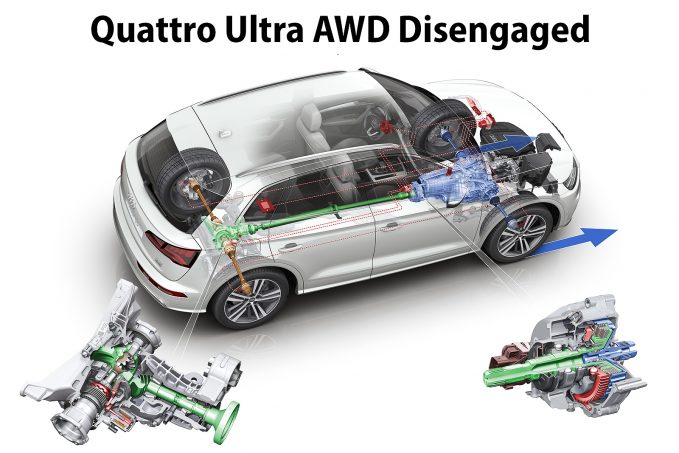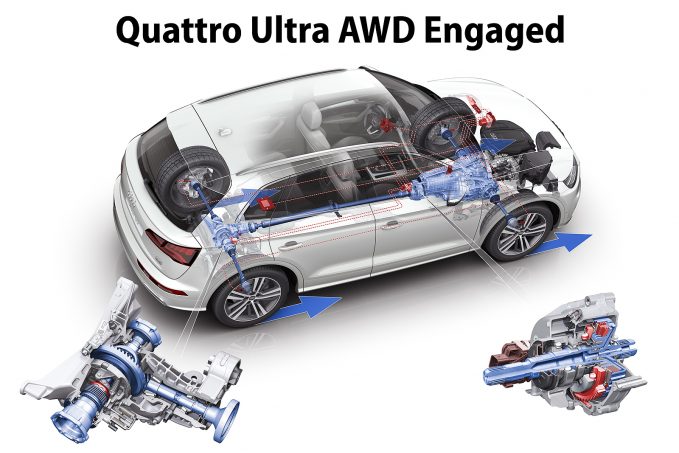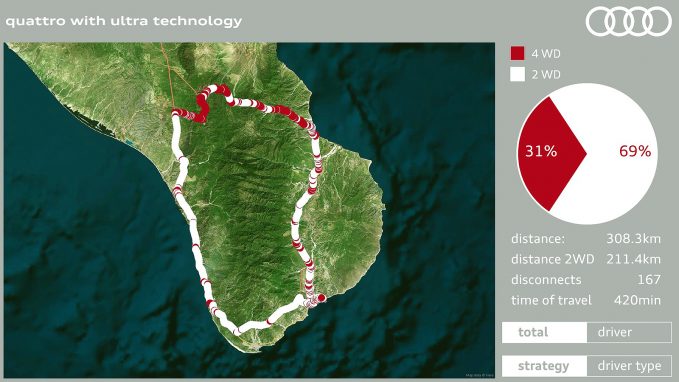Audi may not have invented all-wheel drive, but it’s safe to say the German automaker has pretty much perfected it over the years.
Introduced in 1980, Audi’s Quattro all-wheel drive has become as synonymous with the brand as its four-ring logo. Helping its cause is just how tremendously reliable the system has been, providing peace of mind and performance for almost four decades. And now the automaker is looking to add efficiency to that list, with a new all-wheel drive system dubbed Quattro Ultra that breaks from the norm and operates as a front-wheel drive setup first and foremost, with power heading rearwards only when needed.
“The idea is to improve fuel efficiency, and this is done by making sure the vehicle is in all-wheel drive when all-wheel drive is required,” said Rolf Kronstorfer, Audi’s head of advanced transmission engineering and all-wheel drive development. “But if all-wheel drive is not required, then we switch to front-wheel drive.”
How it Works
Sounds simple, right? In theory, perhaps, but not in practice. Designing a drivetrain that functions in two manners, not to mention doing so completely independent of driver input, is no easy task. Complicating matters further is the system’s ability to work in both predictive and reactive fashions, analyzing inputs like steering angle, engine torque, acceleration and, of course, traction, to decide whether power should be delivered to all four wheels, or just the front two.
“The predictive strategy works by looking at different [data inputs],” Kronstorfer said. “It looks at how they are applied and which way they are applied. Additionally, it looks at vehicle speed, we look at engine rpm and which gear is chosen, and therefore we can predict the torque that we need to transfer to the street.”
ALSO SEE: 2017 Cadillac CT6 vs 2017 Genesis G90
If the system justifies it, Quattro Ultra will send 100 percent of available power to the front wheels by disengaging the front clutch, located at the transmission, and a second one fitted inside the rear differential. When additional traction is needed — say, when driving on sand or loose gravel, or accelerating hard through a corner — both clutches are engaged, pushing a portion of that power rearwards.
The entire process of switching to all-wheel drive can be completed in about 200 milliseconds if needed, according to Kronstorfer, but the plan is to use the predictive strategy to make the decision before four-wheel traction is needed.
“The idea really to make sure that Quattro Ultra is driving like the [existing] Quattro system so that you never have the impression or the feeling that the car is sometimes in front-wheel drive and sometimes in all-wheel drive,” he said.
Splitting Torque
When it comes to torque split, the ratio of power divided between the two sets of drive wheels, Quattro Ultra can send all of its power to the front wheels, but not vice versa. This, of course, is a result of the system’s ability to operate in front-wheel drive but not rear-wheel drive, though it can send the majority of the available power to the rear wheels under certain conditions.
ALSO SEE: 2017 Cadillac XT5 Platinum AWD Review
“If you only focus on static driving conditions, then every [system] has a maximum torque split of 50/50 because you can’t do more than lock it,” Kronstorfer said. “But if you focus on dynamic driving behavior — so, for example, accelerating — then you have a transfer of weight from the front of the car to the rear axle, and if you have more weight of the car on the rear axle you can transfer more torque. And then it automatically switches to 40/60 or 30/70 front/rear split.”
Saving Fuel
The main goal of Quattro Ultra is to reduce fuel consumption, something Audi claims it has proven — and not just in a controlled environment. According to the automaker, internal testing in live traffic scenarios in Germany found an average fuel consumption improvement of a little less than one mpg (0.3 L/100 km) compared to the same vehicle without Quattro Ultra. That may not seem like much, and probably benefits Audi’s emissions targets more than the average consumer, but every little bit helps. Crunching the numbers using the U.S. EPA’s fuel economy rating model, driving 15,000 miles annually would result in about two tanks worth of gas saved over the course of a year.
But Does it Work?
First introduced on the 2017 Audi A4 Allroad wagon, the automaker is now ready for Quattro Ultra’s first true test: The 2018 Audi Q5. With the automaker launching a redesigned version of its best-selling vehicle, it has implemented Quattro Ultra in a model for the masses.
Driving the combination of twisting asphalt and gravel roads and sandy beaches of Mexico’s Baja California, Quattro Ultra was up to the task, providing impressive traction when needed. The Q5 has long been among the most surefooted premium crossovers on the market, and the dual-drive powertrain did nothing to change that.
ALSO SEE: 2018 Audi Q5 Review
At the end of our day-long excursion, results tallied using a real-time analysis program proprietary to Audi showed one tester had 167 disconnects — the number of times the system switched out of all-wheel drive — resulting in 69 percent of the roughly 192-mile (308-kilometer) journey being completed in front-wheel drive.
But the key to the whole system is its imperceptibility, with Quattro Ultra making the transition between two- and four-wheel drive — and back again — without the driver noticing, something it delivered on during our time behind the wheel.











